
The Carib grackle is a New World tropical blackbird, a resident breeder in the Lesser Antilles and northern South America east of the Andes, from Colombia east to Venezuela and northeastern Brazil. There are eight subspecies, of which the most widespread is the nominate subspecies of Trinidad and the South American mainland. This subspecies was introduced to Tobago in 1905 and is now common there.

The arboreal salamander is a species of climbing salamander. An insectivore, it is native to California and Baja California, where it is primarily associated with oak and sycamore woodlands, and thick chaparral.

The crested kingfisher is a very large kingfisher that is native to parts of southern Asia, stretching eastwards from the Indian Subcontinent towards Japan. It forms a species complex with the other three Megaceryle species.
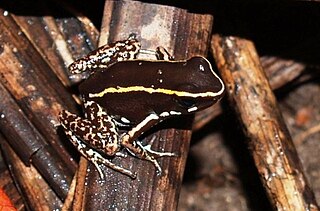
The lovely poison frog or lovely poison-arrow frog is a species of frog in the family Dendrobatidae. It is found on the Caribbean versant of Central America from southeastern Nicaragua through Costa Rica to northwestern Panama, with one record just west of the Panama Canal. Populations from the Pacific versant, formerly included in this species, are now identified as Phyllobates vittatus.

The Senegal lapwing or lesser black-winged lapwing is a species of bird in the family Charadriidae. It is found in Angola, Burundi, Cameroon, Republic of the Congo, Democratic Republic of the Congo, Ivory Coast, Gabon, Gambia, Ghana, Guinea, Kenya, Liberia, Malawi, Mali, Mozambique, Nigeria, Rwanda, Senegal, Sierra Leone, Somalia, South Africa, Swaziland, Tanzania, Togo, Uganda, Zambia, and Zimbabwe.

The ash-breasted antbird is an insectivorous bird in the antbird family, Thamnophilidae. It is found in Brazil, Colombia, Ecuador, and Peru. Its natural habitat is subtropical or tropical moist lowland forests.
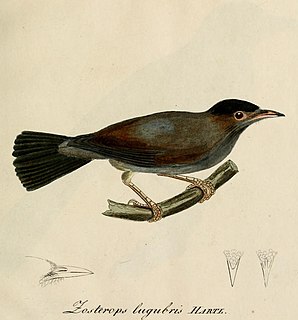
The black-capped speirops is a species of bird in the family Zosteropidae. It was previously placed in the genus Speirops. It is endemic to São Tomé and Príncipe.
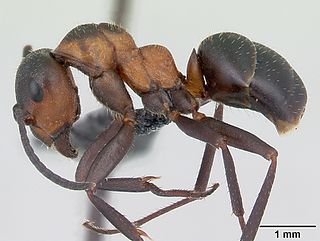
Formica lugubris, also known as the hairy wood ant is commonly found in wooded upland areas across northern Eurasia. Colonies construct large thatched mound nests occupied by thousands of workers, and one or more queens. Workers look similar to other species of wood ants, but Formica lugubris workers can be identified by a fringe of hairs that reaches down to their eyes and prominent hairs between the facets of their compound eyes. Workers can reach sizes of up to 9 mm long; queens are larger, reaching 12 mm long.

Lepidodactylus lugubris, known as the mourning gecko or common smooth-scaled gecko, is a species of lizard, a gecko of the family Gekkonidae.

The square-tailed drongo-cuckoo is a species of cuckoo that resembles a black drongo. It is found in Sri Lanka and Southeast Asia and is a summer visitor to the Himalayas from Kashmir to eastern Bangladesh. The calls are series of piercing sharp whistles rising in pitch but shrill and choppily delivered.

The fork-tailed drongo-cuckoo is a species of cuckoo that resembles a black drongo. It is found resident mainly in peninsular India in hill forests although some specimens are known from the Himalayan foothills. It can be easily distinguished by its straight beak and the white barred vent. It has a deeply forked tail often having a white spot on the back of the head. The song has been described as a series of 5 or 6 whistling "pip-pip-pip-pip-pip-" notes rising in pitch with each "pip".

Acanthina, common name the unicorn snails, is a genus of small predatory sea snails, marine gastropod mollusks in the family Muricidae, the murex snails or rock snails.
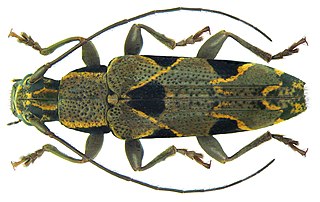
Tmesisternini is a tribe of beetles in the subfamily Lamiinae containing the following genera:
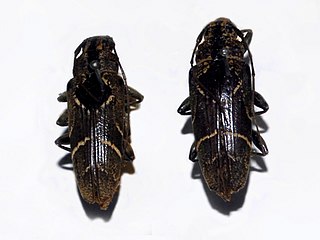
Tmesisternus is a genus of longhorn beetles belonging to the family Cerambycidae, subfamily Lamiinae.

Heliobolus lugubris, also known commonly as the bushveld lizard, mourning racerunner, or the black and yellow sand lizard, is a species of lizard in the family Lacertidae. The species is native to southern Africa.

Tmesisternus distinctus is a species of beetle in the family Cerambycidae. It was described by Jean Baptiste Boisduval in 1835.
Tmesisternus dubius is a species of beetle in the family Cerambycidae. It was described by Xavier Montrouzier in 1855.
Tmesisternus jaspideus is a species of beetle in the family Cerambycidae. It was described by Jean Baptiste Boisduval in 1835.
Tmesisternus schaumii is a species of beetle in the family Cerambycidae. It was described by Francis Polkinghorne Pascoe in 1867. It is known from Moluccas, Australia, and the Solomon Islands.

The Ethiopian cisticola is a species of bird in the family Cisticolidae. It is found in south-central Africa.















